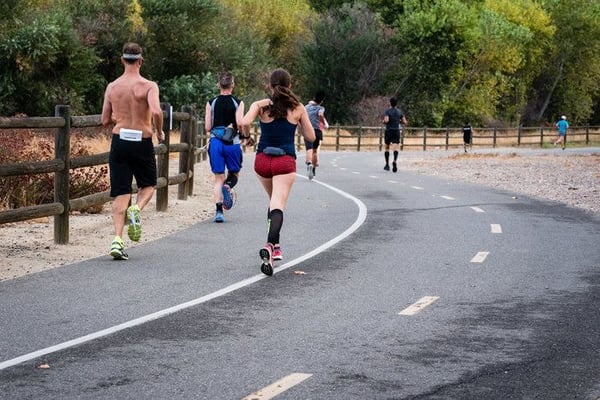So you want to run a 5k?

Running your first 5k, whether it is your first race ever or your first race in a long time, is a great goal. Races can be such a fun experience with other like-minded individuals there along with you and spectators cheering you on. The energy of a race is very inspiring and fun. Plus, many 5ks are raising funds for important causes.
A 5k is usually the first type of race for most since there are many 5k runs and walks available to choose from and it is one of the shortest you can do at 3.1 miles. It is short compared to a half marathon or full marathon, but it is not easy without training. It is important to prepare well for the race to help prevent injuries, make the experience more enjoyable and to get you to the finish.
Here are a few things to keep in mind for your first 5k.
Get good running shoes
The best part about running is that it doesn’t require any fancy equipment or memberships, you just need a pair of shoes and to start running. However, using just any old pair of shoes isn’t the best idea. Today’s running shoes are scientifically created to support your specific biomechanics to protect your body from the incessant pounding of running. A running store will have trained associates who can watch your gait, as well as the way your foot hits the ground, and then be able to suggest the best shoe for your foot and body. A good rule of thumb is to replace your shoes after 300-400 miles. The midsole materials can break down without other signs of wear on the exterior of the shoe, so don’t just go by how they look.
Follow a training plan
There are many training plans online and apps that will help find the right plan for you. My favorite app is Couch to 5k that will break down your running plan for the nine weeks prior to the race. It will tell you which days to run during the week and will break down each run into times to run and walk. When just starting out, you will alternate between running and walking. At first your time walking will be more than running. For example, walk for 4 minutes then run for 1 minute and repeat. Gradually you will increase your run time and reduce your walk time. It is best to make this transition slowly and a good plan should help with that. The plan will also list days to cross train or rest. Having the app right on your phone makes it easy to keep track of your training, but of course you can also find a similar training plan online and print it out if you prefer paper tracking.
Don't Run every day
The schedule should always include at least one rest day each week. Recovery time is important for anyone exercising regularly to allow your body to heal and take a break. Your rest day can be a day off completely from exercise or it can be more of an active rest where you do something like a restorative gentle yoga class or a light walk. Sleep is an important part of recovery as well. Make an effort to get 6-8 hours of sleep each night to support your training as well as your overall health.
Run Outside
Running outside should be part of your training. There are races throughout the year but most occur in the spring. This means many people are training for their 5k during the beginning of the year for that spring race. This time of year here in the Midwest we have some bitterly cold days and snowy days that may cause you to run to (and on) the treadmill. The treadmill can be used for part of your training, however, make a point to run outside for at least some of your runs. Don’t get me wrong, the treadmill isn’t the enemy, there are many benefits to running or walking on the treadmill. But running outside is where your race will be so you should be prepared for that terrain and the conditions you will experience outdoors. Also, running outside is a little more difficult than the treadmill since the treadmill does some of the work for you by feeding the belt to you. Running outside requires more muscle activation because your feet have to grab the ground to propel you and you may be running in different patterns, for example when moving side to side to pass people or hopping over curbs. If you are running on the treadmill, research suggests that setting the machine to a 1 percent grade more accurately simulates outdoor running at certain speeds.
Cross Train
Cross training is important to support the muscles, tendons, ligaments and joints that you use during your run and will help to prevent injuries. I would encourage a total body strength training routine for anyone, but it is an especially important part of a runner’s workout routine. For runners, at a minimum lower body moves with either weights and/or your body weight and core work should be part of your resistance training. When you run, your hamstrings bear most of the brunt of your stride and can tighten, which can lead your quadriceps to weaken. Your back may feel stressed if you don’t have a strong core. Yoga can also be beneficial for runners since it will lengthen your muscles and strengthen your core, among other benefits. Other cross training ideas such as cycling, swimming or stairclimbing will also help strengthen the muscles that don’t get as strong when you run. Cross training doesn’t just help to prevent injury, it will also make you a better runner and may even make running feel easier. You can find great group exercise classes at LivRite perfect for cross training or a personal trainer can also help you with a strength training routine to support your race goals.
Be Sure to warm up
Warm up prior to your run (or any workout). This is another important step that helps to ward off injuries. Brisk walking or dynamic stretching will increase your blood flow and help to loosen your muscles and joints. Save any static stretching (holding a stretch) until after your run.
And Cool Down
Cool down and stretch after every run. Stretching helps ease your tired muscles and prevents them from getting too tight. Excessive muscle tightness could possibly lead to pain, decreased range of motion or injury. When you stretch, do so gradually and hold the position for 15-20 seconds. Do not bounce and never force the stretch past the point of comfort.
Have fun and make a goal
Running is a great way to stay fit. It can also be a great way to meet friends or to have time by yourself and a way to relieve stress. Having a goal of finishing a 5k will help push you through the days when running feels very hard and appreciating the days when it seems easier. By training smart, sticking with your training and completing your goal, you will know you can achieve anything you set out to do.
“Running isn’t about winning or losing, it’s neither about glory or achievement, it’s all about not quitting.”
Ben Vachon


